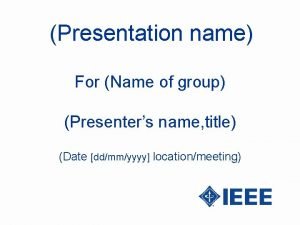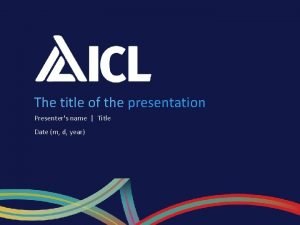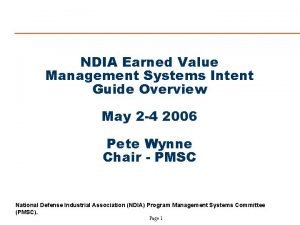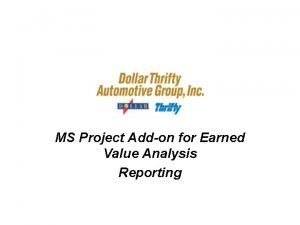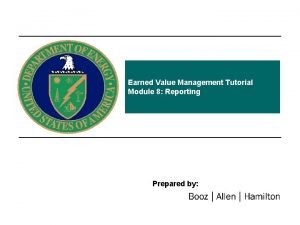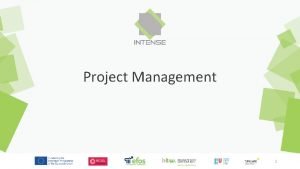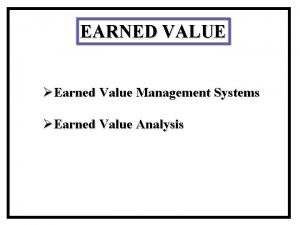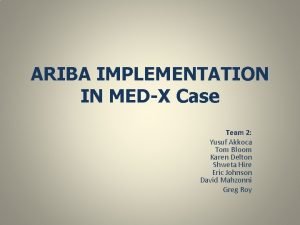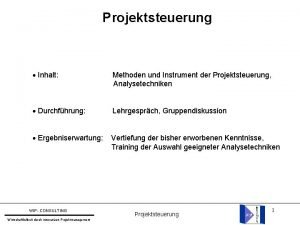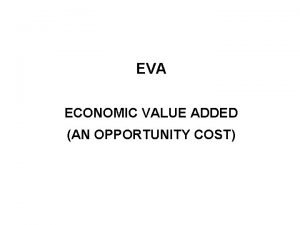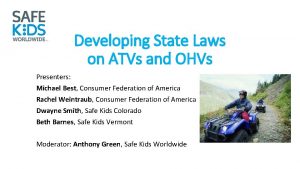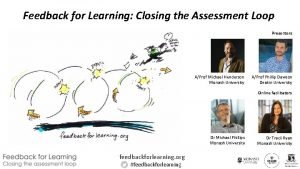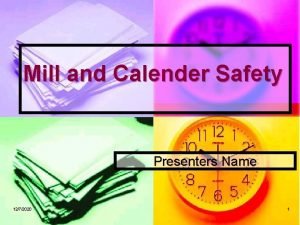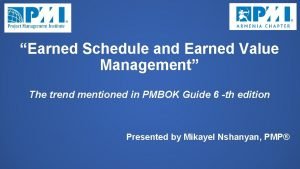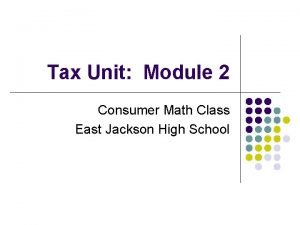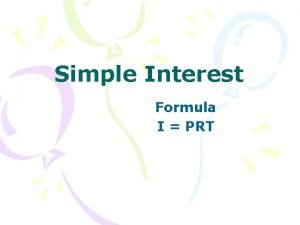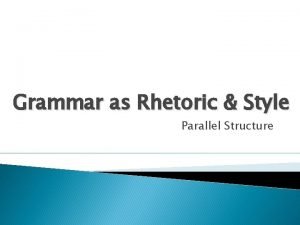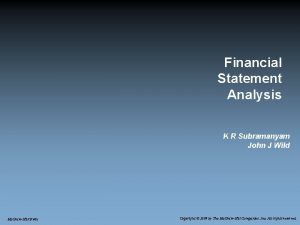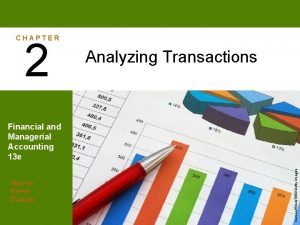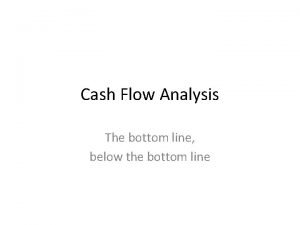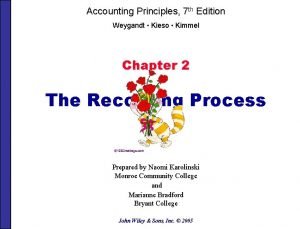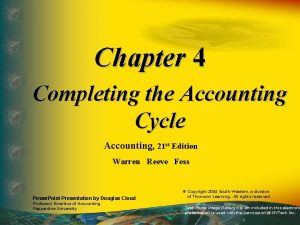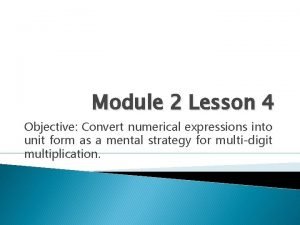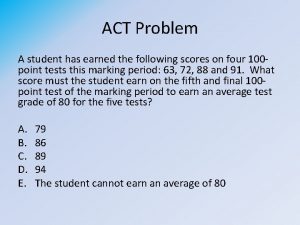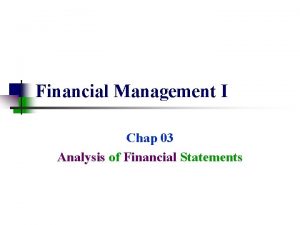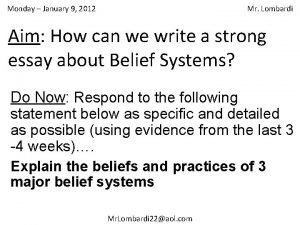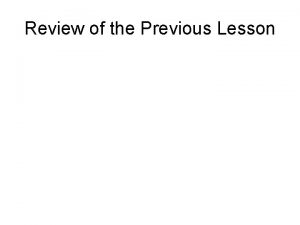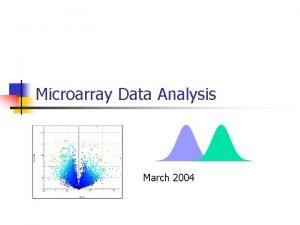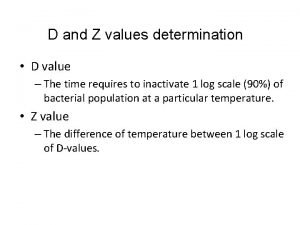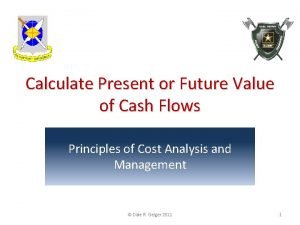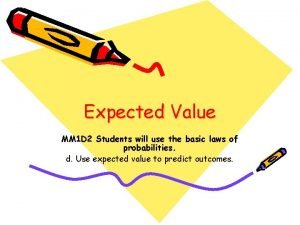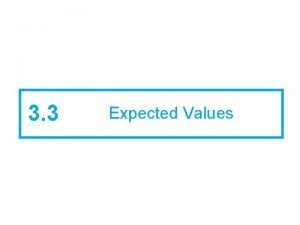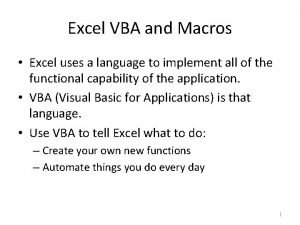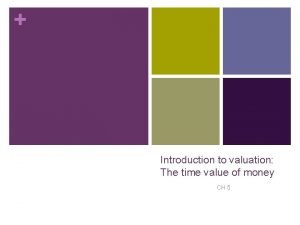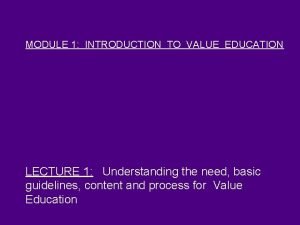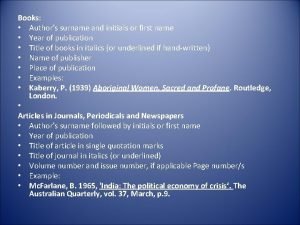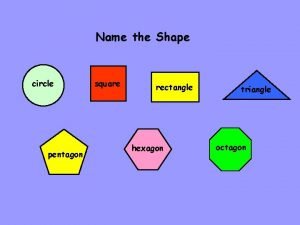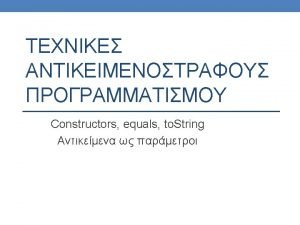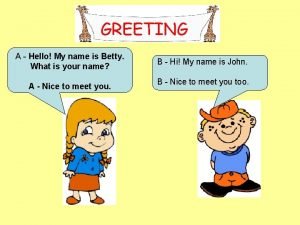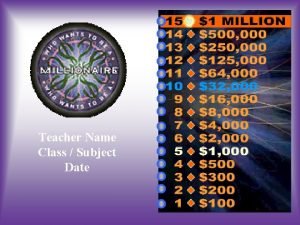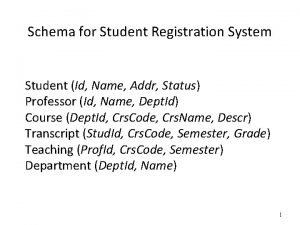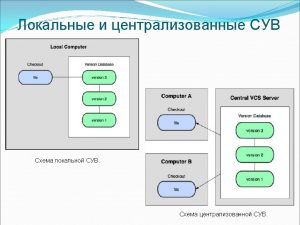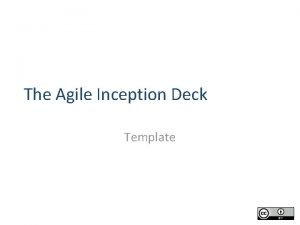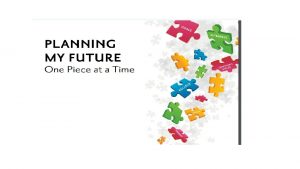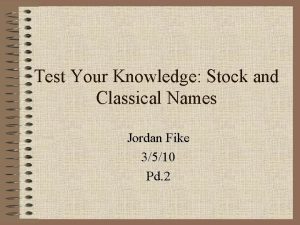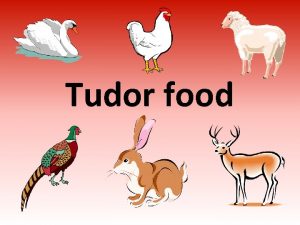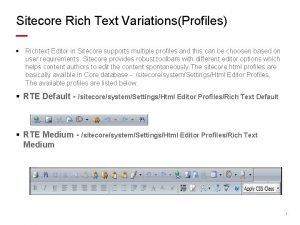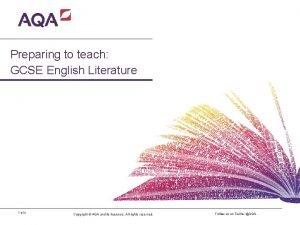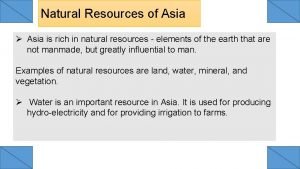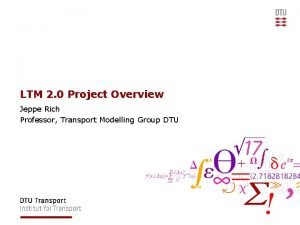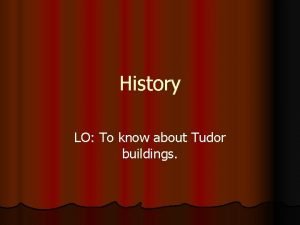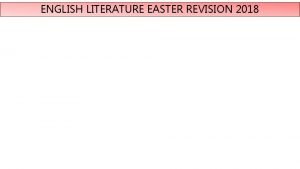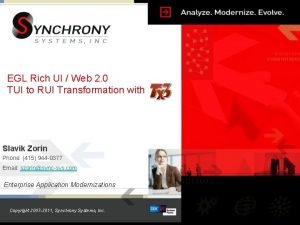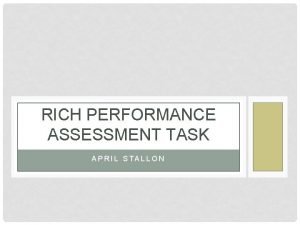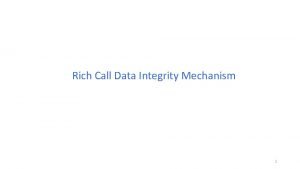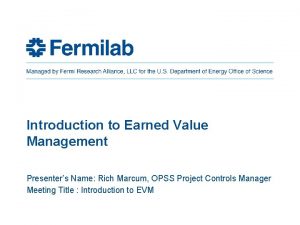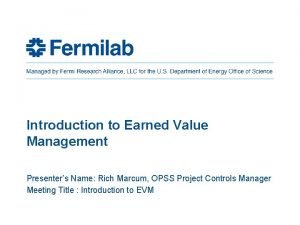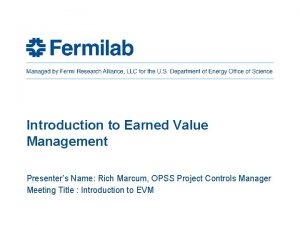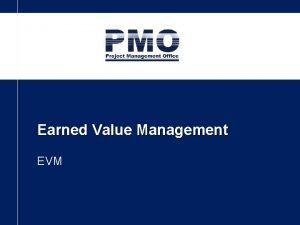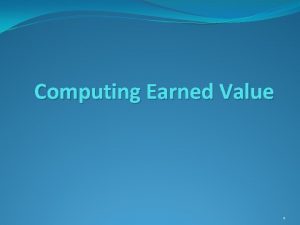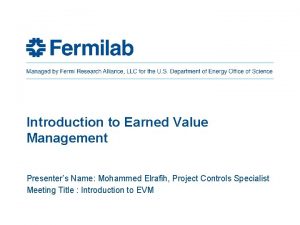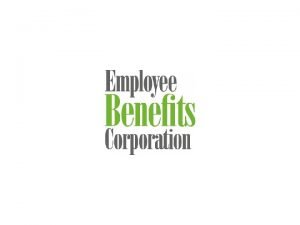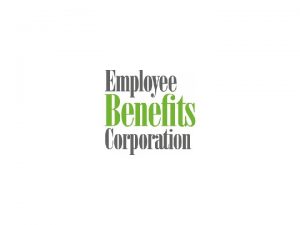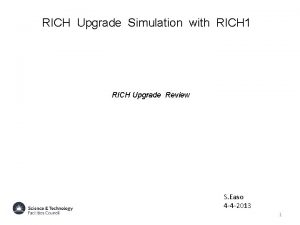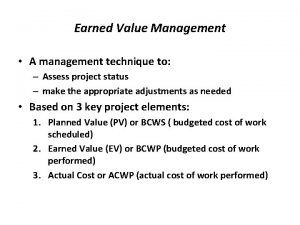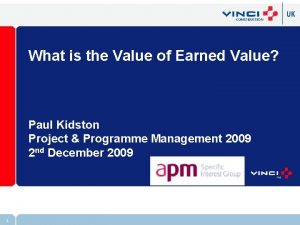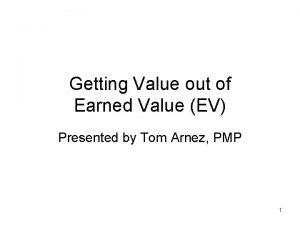Introduction to Earned Value Management Presenters Name Rich






















































































































- Slides: 118

Introduction to Earned Value Management Presenter’s Name: Rich Marcum, OPSS Project Controls Manager Meeting Title : Introduction to EVM

What we will NOT Learn • A lot of Trivia/History (Utilize the Friday Principle) • How to Plan • How to Schedule • How to Implement • Make Expert EVM Practitioners – Not discuss all aspects/tools – Focused Approach 2 Rich Marcum | Introduction to EVM 11/3/2020

Objectives • Understand Reason for EVM • Basic Understanding of EVMS – – – – EVMS vs Traditional Cost Management Earning Value (Progress Reporting) EVM Terminology EVM Indicators/Calculations EVM Principles EVM Practices EVM Responsibilities • Those Online: Please send email rmarcum@fnal. gov – Who is participating with you – all participant’s email – I will send you material 3 Rich Marcum | Introduction to EVM 11/3/2020

Class Guidelines • Please be Courteous • Please Ask Questions • Please Participate 5 Rich Marcum | Introduction to EVM 11/3/2020

Why EVMS • Required by DOE and other Government agencies to Obtain Funding for Projects – DOE Order 413 -B “Establish, maintain and execute the EVMS Certification and Surveillance Review processes in accordance with established levels and in coordination with the PMSO to ensure full compliance with applicable ANSI, FAR and OMB requirements. ” - Office of Management and Budget (OMB) Circular A-11, Part 7: “All major acquisitions with development effort will include the requirement for the contractor to use an Earned Value Management System (EVMS) that meets the guidelines in ANSI/EIA Standard – 748 to monitor contract performance. ” • Allow Lab to get funding for future projects – Show we can manage a project – Demonstrate to stakeholders we are responsible agents of their trust – Establish/build Trust – Requirement for CD 2 & CD 3 (New 413 rev >10 M have certified) 6 Rich Marcum | Introduction to EVM 11/3/2020

Why EVMS – Bit of History • Some Contractors look at Government Contracts as “Cash Cows” without regard for Cost Over-runs and Schedule Adherence. • Other’s Demonstrated Inability to meet Cost and Schedule Constraints. Scope (Work) Budget (Cost) Schedule (Time) • 1960 Do. D Introduces fore runners • 1980 to 90 evolved to simplified EVM under the direction of Undersecretary of Defense for Acquisition • 1991 Canceled $57 B Work based on EVM • 1998 Establishment of ANSI 748 • 2005 -11 Revisions to FAR standards emphasizing need for EVMS 7 Rich Marcum | Introduction to EVM 11/3/2020

Earned Value Management System - Simplified Earned Value Management System Management Processes (How) 8 Rich Marcum | Introduction to EVM Management of Project Deliverables (What) Management of People (Who) 11/3/2020

Traditional Cost Management Evaluation Process • Compares a projects planned-to-date costs to its actual-todate costs Planned Costs - Actual Costs = Underrun or Overrun • Positive value indicates an underrun • Suggests a healthy project • Expectation the project will be completed under-budget • Negative value indicates an overrun • Suggests performance issues • Expectation the project will be completed over-budget 9 Rich Marcum | Introduction to EVM 11/3/2020

Example: Traditional Cost Management • Example indicates a performance underrun: $500 K - $400 K = $100 K 10 Rich Marcum | Introduction to EVM 11/3/2020

Earned Value Process • New component not found in traditional evaluation process – Earned Value • Measure of work actually performed • % Complete x Budget at Completion = Earned Value • Comparing Earned Value to other components derives variances • • 11 Earned Value - Actual = Cost Variance Earned Value - Planned Value = Schedule Variance Positive variances indicate healthy performance Negative variances indicate performance issues Rich Marcum | Introduction to EVM 11/3/2020

Example: Earned Value Process • Cost and schedule variances used to calculate and determine a project's forecast Traditional Indication showed +100 K i. e. underrun 12 Rich Marcum | Introduction to EVM 11/3/2020

EVMS Official Definition An Earned Value Management System (EVMS) is the overall methodology that organizations use to plan, manage, control, and analyze the cost and schedule performance of projects. It encompasses organizational policies, business processes, automation support, standards, and accountability for results. ANSI-EIA Standard 748 13 Rich Marcum | Introduction to EVM 11/3/2020

Earning Value (Performance Reporting) Ø Earned Value falls into 2 main categories: • Non-discrete (aka management tasks - LOE) • Discrete (specific deliverable) Ø Level of Effort is an example of non-discrete EV methods Ø Guidance for LOE Activities • • 14 Keep LOE to Minimum Ensure LOE is used only when You Can’t Measure Progress LOE should be Minimized relative to Total Project Cost Minimize mixing of LOE and Discrete Work • Mixed Accounts Follow 85/15 rule i. e. Max of 15% • Separate CTCs – No mixing of LOE & Discrete at CTC level • Separate Reports Rich Marcum | Introduction to EVM 11/3/2020

Earned Value Methods Ø Examples of discrete EV methods: • • • Physical % complete (incremental earning based on PMs assessment of %) Milestones (30% design, 60% design, etc. ) 0/100 (performance is earned after all work is complete) 100/0 (performance is earned at the start of the work) 50/50 (50% earned at start; 50% earned at finish) Units complete Ø Remember, the method you choose must be objective and consistent throughout the project 15 Rich Marcum | Introduction to EVM 11/3/2020

FRA EVM System process is found in procedures • FNAL Procedures (System) • • • Project WBS, OBS, RAM Control Accounts, Work Packages, Planning Packages Work Authorization Project Scheduling Cost Estimating Monthly Status Reporting Change Control EVMS Surveillance & Maintenance EVMS Description • Know • Reference • Use 16 Rich Marcum | Introduction to EVM 11/3/2020

Earned Value Management System EVMS is not a software product or tool, but rather a collection of management practices used to: • Plan all work scope • Breakdown work scope into finite pieces • Assign Work to a responsible person or Scope organization (Work) • Integrate the work scope, cost, and schedule - Performance Measurement Baseline (PMB) Budget Schedule • Routinely access project's progress and actual (Cost) (Time) costs • Perform Corrective Actions • Control Scope Increases • Forecast Project Completion • Report with Transparency 17 Rich Marcum | Introduction to EVM 11/3/2020

Navigation to EVMS Procedures www. fnal. gov Go to Bottom 18 Rich Marcum | Introduction to EVM 11/3/2020

Navigation to EVMS Procedures (Cont. ) www. fnal. gov 19 Rich Marcum | Introduction to EVM 11/3/2020

OPSS Sharepoint 20 Rich Marcum | Introduction to EVM 11/3/2020

Getting to Procedures & Guidelines – Policies & Procedures https: //web. fnal. gov/organization/OPSS/Pages/EVMSDocumentation. aspx 21 Rich Marcum | Introduction to EVM 11/3/2020

OPSS Share. Point 22 Rich Marcum | Introduction to EVM 11/3/2020

FNAL OPSS Share. Point Guidance 23 Rich Marcum | Introduction to EVM 11/3/2020

FNAL OPSS Share. Point Guidance 24 Rich Marcum | Introduction to EVM 11/3/2020

FNAL OPSS Share. Point Guidance (Cont. ) EVMS Information 25 Rich Marcum | Introduction to EVM 11/3/2020

FNAL OPSS Share. Point Guidance (Cont. ) EVMS Surveillance Reviewer Materials 26 Rich Marcum | Introduction to EVM 11/3/2020

EVM Fundamental Standard • Industry-wide standard for EVMS – ANSI 748 • Organized into five categories containing 32 Criteria o Organization - 5 criteria o Planning, Scheduling, and Budgeting - 10 criteria o Accounting Considerations - 6 criteria o Analysis and Management Reports - 6 criteria o Revisions and Data Maintenance - 5 criteria 27 Rich Marcum | Introduction to EVM 11/3/2020

EVM Cat 1 – Organization (GL 1 -5) 1. 2. 3. 4. 5. 28 Define Work Scope (WBS) Define Project Organization (OBS) Integrate Processes Identify Overhead Management Integrate WBS/OBS to Create Control Accounts Rich Marcum | Introduction to EVM 11/3/2020

Work Breakdown Structure & Dictionary -Example (12. PM-001) What WBS related to EVMS Guidelines 1, 3, 5, 17, 18, 19 & 25 29 Rich Marcum | Introduction to EVM 11/3/2020

Control Account (Key Element Touched by All Procedures) Marriage of OBS and WBS (Who & What) For new Projects use separate WBS for LOE CA Related to most EVMS Guidelines as it relates to RAM, Schedule, WBS, WAD, Etc. 30 Rich Marcum | Introduction to EVM 11/3/2020

Responsibility Assignment Matrix – RAM (12. PM-001) Who & What RAM Related to EVMS Guidelines 2, 3, 5, 9 & 18 31 Rich Marcum | Introduction to EVM 11/3/2020

EVMS Responsibility seen from 40, 000 Feet RESPONSIBILITY BUDGET ELEMENT Total Project Cost CUSTOMER Contingency Management Reserve Performance Measurement Baseline / Budget at Completion PROJECT MANAGER Undistributed Budget Control Accounts CONTROL ACCOUNT MANAGER Work Packages 32 Rich Marcum | Introduction to EVM Planning Packages CAM Summary Responsibilities on Next Slide 11/3/2020

Work Authorization Document – Example (12. PM-003) Required ~7 months Prior to CD-2 WAD Related to EVMS Guidelines 3, 6, 8 & 29 33 Rich Marcum | Introduction to EVM 11/3/2020

WAD Attachments Examples: Schedule & CAP Ø WAD information is incomplete without these attachments Ø Procedure outlines required fields for these reports 34 Rich Marcum | Introduction to EVM 11/3/2020

EVM Cat 2 – Planning, Scheduling, and Budgeting (GL 6 -15) 6. Schedule with Network Logic 7. Set Measurement Indicators 8. Establish Budgets for Authorized Work 9. Budget by Cost Elements 10. Create Work Packages, Planning Packages 35 Rich Marcum | Introduction to EVM 11/3/2020

Scheduling Flowchart (12. PM-002) MS are segregated into Tiers of Importance or Oversight Schedule Related to EVMS Guidelines 3, 5, 6, 7, 8, 10, 11, 12, 15, 22, 23 &28 36 Rich Marcum | Introduction to EVM 11/3/2020

Scheduling Flowchart (Cont. ) 37 Rich Marcum | Introduction to EVM 11/3/2020

Planning Package Vs Work Package RESPONSIBILITY BUDGET ELEMENT Total Project Cost CUSTOMER Contingency Management Reserve Performance Measurement Baseline / Budget at Completion PROJECT MANAGER Undistributed Budget Control Accounts CONTROL ACCOUNT MANAGER Work Packages 38 Rich Marcum | Introduction to EVM Planning Packages • Less defined • Higher Estimate Uncertainty • Converted to WP prior to 1 Month before working • Longer Duration Prior to CD-2: • May have more PP • Less restrictive WP Criteria 11/3/2020

EVM Cat 2 – Planning, Scheduling, and Budgeting (GL 6 -16) 11. Sum Detail Budgets to Control Account 12. LOE Planning and Control 13. Establish Overhead Budgets 14. Identify Management Reserve and Undistributed Budget 15. Reconcile to Target Cost Goal 39 Rich Marcum | Introduction to EVM 11/3/2020

EVM Cat 3 – Accounting Considerations (GL 16 -21) 16. Record Direct Costs 17. Summarize Direct Costs by WBS Elements 18. Summarize Direct Costs by OBS Elements 19. Record/Allocate Indirect Costs 20. Identify Unit and Lot Costs 21. Track and Report Material Costs and Quantities 40 Rich Marcum | Introduction to EVM 11/3/2020

Collecting Costs • Fermilab’s Oracle e. BS (electronic Business Suite) – Collects Actual Costs – Accruals • Automatic for Material Received at Fermilab • Manual for Services & Materials Received Elsewhere • Indirects are applied – Rates set at Least Annually by CFO • Adjusted at Fiscal Year End to reflect Actual Indirect Costs at Fermilab • May be Adjusted at Interim Dates – Opportunities for Pass-through Rates – Cap for Large Qualified Purchase Orders at $500 K 41 Rich Marcum | Introduction to EVM 11/3/2020

Collecting Actual Costs and Hours • Labor – Kronos collects Fermilab Labor Hours & Feed e. BS – Labor at other Institutions • Actual Costs are Collected as M&S • Scheduled as “Non-Labor” in Primavera P 6 • M&S – Actual Costs input to e. BS accounting system – Accruals (virtual actuals) are input to e. BS accounting sys • Monthly Interface with Cobra – Actual Costs and Hours are Extracted from e. BS – Loaded into Cobra by PCS (See Graphic on Monthly Status Reporting Cycle) – Cobra and e. BS Totals are Reconciled Note: e. BS is electronic Business Suite 42 Rich Marcum | Introduction to EVM 11/3/2020

EVM Cat 4 – Analysis and Management Reports (GL 22 -27) 22. Calculate Schedule Variance and Cost Variance 23. Identify Significant Variances for Analysis 24. Analyze Indirect Cost Variances 25. Summarize Information for Management 26. Implement Corrective Actions 27. Revise Estimate at Completion (EAC) 43 Rich Marcum | Introduction to EVM 11/3/2020

Monthly Reporting Flowchart (12. PM-006) Monthly Reporting related to EVMS Guidelines 17, 18, 19, 21, 22, 23, 24, 25, 26, 27, 28, 29 & 30 44 Rich Marcum | Introduction to EVM 11/3/2020

Monthly Process Calendar 45 Rich Marcum | Introduction to EVM 11/3/2020

FRA EVMS Process –Analysis & Management Reporting 46 Rich Marcum | Introduction to EVM 11/3/2020

Project Life Cycle – Monitor & Control Review 47 Rich Marcum | Introduction to EVM 11/3/2020

Update the Schedule - Verify 38411. 160 38412. 350 38412. 380 #2639 started on time, is ahead of schedule and is projected to finish on time. #2640 started on time, but has not completed as planned (was planned as one day duration). #2644 should have started one period ago but did not. Duration is expected to happen as planned. Data date #2647 is being pushed by predecessor, #2644 not finishing as planned. #2649 is suspect of poor status or not meeting planned expectations as it started very early, but appears to be finishing very late. #2653 and MS #2654 are being pushed by #2649 finishing late. • P 6 is a dynamic scheduling tool • resource loaded • logically tied • analyze schedule after every update • Scheduler • CAM • ensure proper status has been taken 48 Rich Marcum | Introduction to EVM 11/3/2020

Monthly Reporting: Contract Performance Report Example 49 Rich Marcum | Introduction to EVM 11/3/2020

EVM Cat 5 – Revisions and Data Maintenance (GL 28 -32) 28. Incorporate Changes in a Timely Manner 29. Reconcile Current to Prior Budgets 30. Control Retroactive Changes 31. Prevent Unauthorized Revisions 32. Document PMB Changes 50 Rich Marcum | Introduction to EVM 11/3/2020

Change Control • After Baseline is established – All changes to Plan are prohibited without proper authority and documentation – Never change history • Reason to change baseline includes – – Scope changes Schedule changes Unforeseen Risk Mitigation Manage Control Account (changes from Plan…Future) • Baseline does not change for – Past Inadequate planning – Past Poor estimates – Performance variations (good/bad) 51 Rich Marcum | Introduction to EVM 11/3/2020

Change Control Flowchart (12. PM-007) Schedule Related to EVMS Guidelines 28, 29, 30, 31 & 32 52 Rich Marcum | Introduction to EVM 11/3/2020

Revisions and Data Maintenance via BCR • Changes Only on Future Work, not to change past performance • Change Control Thresholds are Project Specific – High level Thresholds (DOE’s) are Identified in the Project Execution Plan (PEP). – Lower level Thresholds (FRA’s) are Identified in the Project Management Plan (PMP) • Example 53 Rich Marcum | Introduction to EVM 11/3/2020

Earned Value Management System EVMS is not a software product or tool, but rather a collection of management practices used to: • Plan all work scope • Breakdown work scope into finite pieces • Assign Work to a responsible person or Scope organization (Work) • Integrate the work scope, cost, and schedule - Performance Measurement Baseline (PMB) Budget Schedule • Routinely access project's progress and actual (Cost) (Time) costs • Perform Corrective Actions • Control Scope Increases • Forecast Project Completion • Report with Transparency 54 Rich Marcum | Introduction to EVM 11/3/2020

What is FNAL Certified EVMS • DOE 413 - Projects must have EVMS certified and periodically audited • FNAL Procedures (System) • • • 55 Project WBS, OBS, RAM Control Accounts, Work Packages, Planning Packages Work Authorization Project Scheduling Cost Estimating Monthly Status Reporting Change Control EVMS Surveillance & Maintenance EVMS Description Rich Marcum | Introduction to EVM 11/3/2020

EVMS Tools • CAMs are not expected to be experts at tools used in our EVMS. However, they must know how they are used to control their accounts. • Four primary data tools 1. 2. 3. 4. Primavera P 6 Excel/MS Word Accounting DB Cobra • Four reporting tools 1. 2. 3. 4. 56 Cobra P 6 Excel CAMe Toolbox Rich Marcum | Introduction to EVM Next 4 Slides Describe Tool Details 11/3/2020

FNAL Data Tools - Primavera P 6 • Scheduling tool • • Performance dates Critical path Schedule or time constraint analysis Schedule reports • Used to feed Cobra • Planned & Actual Dates • Resource assignments • Some code information • Not used for • Official budget information (pass through only) • Actual cost information • Forecast information 57 Rich Marcum | Introduction to EVM 11/3/2020

FNAL Data Tools – Excel or MS Word • Used for • • • Documentation of Basis of Estimates Secondary reporting Graphs/Charts Preliminary data analysis Registers or logs Intermediary status tool • Not used for • Primary reporting • Project scheduling 58 Rich Marcum | Introduction to EVM 11/3/2020

FNAL Data Tools – Accounting DB • Used for • Actual cost data – Actual Cost – Actual Hours – Accruals • Validate actual Cobra data • Not used for • Earned value management 59 Rich Marcum | Introduction to EVM 11/3/2020

FNAL Data Tools – Cobra • Used for • PMB data control • Retaining all historical and current EVM data – – • • BCWS BCWP ACWP PMT and Other EVM required coding Forecasting Performance and cost reporting Primary EVM data reporting Variance analysis and reporting • Not used for • Scheduling • Logs and registers 60 Rich Marcum | Introduction to EVM 11/3/2020

Earned Value Management Is • A Standardized approach to assessing progress • Predictive is estimating where a project’s costs and schedules are heading • Diagnostic in locating where the problems are • Proactive by signaling the need for corrective actions • Strategic in identifying the problems and opportunities across multiple elements of a project 61 Rich Marcum | Introduction to EVM 11/3/2020

Demonstration of How to Earned Value 62 Rich Marcum | Introduction to EVM 11/3/2020

Demonstration of How to Earned Value If the deliverable was completion of the FNAL Word Search How would you determine Earned Value? • Hours • Units • Cost 63 Rich Marcum | Introduction to EVM 11/3/2020

Demonstration of How to Earned Value (Hours) Hours • How long did you work on this? • How long should it take (Baseline) • So What is your % complete • Baseline = 20 Min • Spent 5 Min • % Com = 25% 64 Rich Marcum | Introduction to EVM 11/3/2020

Demonstration of How to Earned Value (Units) Units • How many words did you find? • How many words are there (Baseline). 17 • So What is your % complete • Baseline 17 • You completed 5 • % Compt = 29% 65 Rich Marcum | Introduction to EVM 11/3/2020

Demonstration of How to Earned Value (Cost) Cost • How much did you spend (Hours*Rate)? • Cost per Unit? • How much was in the BCWS. • So What is your % complete • Baseline =20 Min @ $100 or $2, 000. • Spent 5 Min * $90 = $450 • % Compt = 22. 5% 66 Rich Marcum | Introduction to EVM 11/3/2020

Demonstration of How to Earned Value (Comparison) Which Method was most accurate, most quantifiable, most defendable? • Hours = 25% • Units = 29% • Cost = 22. 5% WHY? What if after spending 60 min we have 1 left to complete? Do Hours or Cost now hold true? 67 Rich Marcum | Introduction to EVM 11/3/2020

Terminology • Components necessary for determining and analyzing earned value performance: – Planned Value - cost of work that was planned to be accomplished • • Plan Budget BCWS - Budgeted Cost of Work Scheduled Science Related Terminology – Target or Theory – Earned Value - calculated cost of work that was accomplished • BCWP - Budgeted Cost of Work Performed • Science Related Terminology – Results or Outcome – Actual Value - actual amount it cost to perform the work • Actuals • Incurred • ACWP - Actual Cost of Work Performed 68 Rich Marcum | Introduction to EVM 11/3/2020

Other EVM Terminology • Progress • Percentage of physical work completed • Also referred to as Percent Complete • Earned Value Method • • Methods used for progressing control accounts/work packages Selected to produce the best objective results Also called Performance Measurement Technique (PMT) Rules of Credit • Progress Weighting • Applied to schedule Activities to more accurately calculate a control account's progress 69 Rich Marcum | Introduction to EVM 11/3/2020

More EVM Terminology • Budget at Completion (BAC) • Total planned cost for the project • Variance • Deviation from the Baseline (planned) cost or schedule • Positive Variances are Favorable • Negative Variances are Unfavorable • Control Account (CA) • Lowest WBS element assigned to a single focal point to plan and control scope / schedule / budget 70 Rich Marcum | Introduction to EVM 11/3/2020

More EVM Terminology • Performance Measurement Baseline (PMB) • Integrates Scope, Schedule, Cost, Resources, Technical Milestones • Project time-phased budget plan • Used to benchmark cost and schedule performance of project Scope (Work) Budget (Cost) • Total Project Cost (TPC) • Total Cost of Performing Project’s Scope of Work from inception to close. 71 Rich Marcum | Introduction to EVM 11/3/2020 Schedule (Time)

EVM Gold Card – EVMS Terminology/Definitions This block has been modified to better Represent FNAL 72 Rich Marcum | Introduction to EVM 11/3/2020

EVM Indicator Calculations • Earned Value • Cost of work accomplished • Earned Value = BAC x Percent Complete • Variances • Cost Variance = Earned Value – Actuals • Schedule Variance = Earned Value - Planned Value 73 Rich Marcum | Introduction to EVM 11/3/2020

EVM Indicator Calculations (Continued) • Estimate to Complete (ETC) • Independent EAC (i. EAC) • Also called Forecast • Remaining cost to complete project • ETC = EAC - Actuals • Calculation for determining the EAC • i. EAC = BAC / CPIcuml • Total forecasted cost of project • EAC = Actuals + ETC • Value of work that has to be completed for every dollar spent to complete the project within budget • TCPI = (BAC - EVcuml) / (EAC - Actualscuml) • To-Complete Performance • Estimate at Completion (EAC) Index (TCPI) • Variance at Completion (VAC) • Total Cost Variance at completion of the project • VAC = BAC + EAC 74 Rich Marcum | Introduction to EVM 11/3/2020

EVM Index • Variances in terms of a ratio • Cost Performance Index = Earned Value / Actuals • CPI of 0. 80 indicates for every dollar spent to accomplish work, 80¢ of work was completed • Schedule Performance Index = Earned Value / Planned Value • SPI of 1. 2 indicates for every dollar of work scheduled to be accomplished, $1. 20 of work was completed • Values above 1. 0 indicate good performance • Values below 1. 0 indicate poor performance 75 Rich Marcum | Introduction to EVM 11/3/2020

Easy Indication Calculation P S SV = 1500 SPI =. 7 76 Rich Marcum | Introduction to EVM A S = 5000 P = 3500 A = 4000 SV=P-S SPI=P/ S CV = -500 CPI =. 875 CV=P-A CPI=P/ A 11/3/2020

Earned Value Management’s Key Concepts “Plan the Work and then Work the Plan” “That which gets measured, gets done. ” Unknown Tom Peters “If you aim for nothing, you will hit it every time. ” Shaun Sherrick Plan 77 Rich Marcum | Introduction to EVM Measure Compare Estimate 11/3/2020

EVM Principles • • • 78 Organize Plan Authorize Execute Monitor Control Rich Marcum | Introduction to EVM Control Monitor Execute Authorize Plan Organize 11/3/2020

EVM Practices (how to meet Principles) • Organize • Plan • Define Project Objectives by establishing KPIs & Milestones • Define Project Plans such as Project Execution Plan (PEP) • Define Project work scope via Work Breakdown Structure (WBS) • Define Project Organization via Organization Breakdown Structure (OBS) • Assign Responsibility via Responsibility Assignment Matrix (RAM) 79 Rich Marcum | Introduction to EVM • Delivery/Product Based Outcome • Schedule • Control Accounts • Work Packages • Planning Packages • • Anticipate Risks/Obstacles Estimate (Budget) Review/Revise Performance Measurement Baseline (PMB) 11/3/2020

EVM Practices (Cont. ) • Authorize • • • 80 Discrete Controllable Level Work Scope Budget Limits Timeline (Schedule) Work Authorization Document (WAD) Rich Marcum | Introduction to EVM • Execute • • Work the Plan Authorized Scope Only Actual Cost Report Progress • Objective • Quantifiable • PMT 11/3/2020

Work Authorization Document (WAD) With Required Attachments • Schedule • Control Account Plan 81 Rich Marcum | Introduction to EVM 10/10/2014

Responsibility Assignment Matrix – RAM (12. PM-001) Who & What RAM Related to EVMS Guidelines 2, 3, 5, 9 & 18 82 Rich Marcum | Introduction to EVM 11/3/2020

EVM Practices (Cont. ) • Monitor • Measure • Cost • Schedule • Performance • Analyze • Deviations/Variances • Forecast via EAC • Report • Control • • • Evaluate Direct Maintain History Scope Creep Maintain Change Logs Maintain Change Documents • Various levels • CA Required • Maintain Corrective Action Logs • Maintain Risk Registers 83 Rich Marcum | Introduction to EVM 11/3/2020

What Does EVMS Measure? § Performance (BCWP – Results) § Budget (BCWS – Target) § Actuals (ACWP – Cost) 84 Rich Marcum | Introduction to EVM S P A 11/3/2020

EVMS Graphs 85 Rich Marcum | Introduction to EVM 11/3/2020

Using EVMS Helps Answers Questions • • • 86 When will the project be completed? What is the likely final cost of the project? Is the project on budget? Will the project finish on time? What is the cause for delays? What is the cause for over-runs? Rich Marcum | Introduction to EVM 11/3/2020

Applying EVMS Guidelines to the Project Phases 1. 2. 3. 4. 5. 6. 7. 8. 9. 10. 11. 12. 13. 14. 15. 16. 17. 18. 19. 20. 21. 22. 23. 24. 25. 26. 27. 28. 29. 30. 31. 32. 87 Rich Marcum | Introduction to EVM Define Work Scope (WBS) Define Project Organization (OBS) Integrate Processes Identify Overhead Management Integrate WBS/OBS to Create Control Accounts Schedule with Network Logic Set Measurement Indicators Establish Budgets for Authorized Work Budget by Cost Elements Create Work Packages, Planning Packages Sum Detail Budgets to Control Account LOE Planning and Control Establish Overhead Budgets Identify Management Reserve and Undistributed Budget Reconcile to Target Cost Goal Record Direct Costs Summarize Direct Costs by WBS Elements Summarize Direct Costs by OBS Elements Record/Allocate Indirect Costs Identify Unit and Lot Costs Track and Report Material Costs and Quantities Calculate Schedule Variance and Cost Variance Identify Significant Variances for Analysis Analyze Indirect Cost Variances Summarize Information for Management Implement Corrective Actions Revise Estimate at Completion (EAC) Incorporate Changes in a Timely Manner Reconcile Current to Prior Budgets Control Retroactive Changes Prevent Unauthorized Revisions Document PMB Changes 11/3/2020

DOE Project CD Process 88 Rich Marcum | Introduction to EVM 11/3/2020

Questions: • • What is EVMS? How is EVMS different than Traditional Cost Management? What are the Principles of EVMS (6)? What are the Practices of EVMS? What can you Learn about your Project using EVMS? What are some of the Indicators used by EVMS? When should you apply EVMS Practices/Principles in your Project? • Which EVMS Practices/Principles are not applicable to your project? 89 Rich Marcum | Introduction to EVM 11/3/2020

When to Apply EVMS to the Project CD Process 1. Define Work Scope (WBS) 2. Define Project Organization (OBS) 3. Integrate Processes 4. Identify Overhead Management 5. Integrate WBS/OBS to Create Control Accounts 6. Schedule with Network Logic 7. Set Measurement Indicators 8. Establish Budgets for Authorized Work 9. Budget by Cost Elements 10. Create Work Packages, Planning Packages 11. Sum Detail Budgets to Control Account 12. LOE Planning and Control 13. Establish Overhead Budgets 14. Identify Management Reserve and Undistributed Budget 15. Reconcile to Target Cost Goal 16. Record Direct Costs 17. Summarize Direct Costs by WBS Elements 18. Summarize Direct Costs by OBS Elements 19. Record/Allocate Indirect Costs 20. Identify Unit and Lot Costs 21. Track and Report Material Costs and Quantities 22. Calculate Schedule Variance and Cost Variance 23. Identify Significant Variances for Analysis 24. Analyze Indirect Cost Variances 90 Rich Marcum | Introduction to EVM 25. 26. 27. 28. 29. 30. 31. 32. Summarize Information for Management Implement Corrective Actions Revise Estimate at Completion (EAC) Incorporate Changes in a Timely Manner Reconcile Current to Prior Budgets Control Retroactive Changes Prevent Unauthorized Revisions Document PMB Changes EVMS is applicable to all CD Phases Require Certified Process at CD-2/3 11/3/2020

Applying EVMS to Project prior to CD 2/3 • • Remember EVMS is a Management tool Don’t Disregard EVMS or other Management Standards Should be applied to All Projects and in All Phases Strict Certified Compliant applications of EVMS are Required at CD 2 and CD 3 phases • Apply EVMS Judiciously to Prevent Overburdening Project during rapidly changing Scope Defining and R&D Cycles • Prior to CD 2/3 Tailored approach can be used 91 Rich Marcum | Introduction to EVM 11/3/2020

EVMS Tailoring (DOE guidance) 92 Rich Marcum | Introduction to EVM 11/3/2020

EVMS Tailoring What does it Mean to FNAL • • Schedule Durations are not limited to ~40 days Higher level of LOE activities are acceptable Estimates less strict i. e. more ROMs are acceptable Resources can be loaded at higher level Cobra Costing Tools is not required Change Logs can be less detailed P 6 Coding rules are less restrictive if not using Cobra Processes can be less proscriptive Remember: Project must be Compliant to EVMS Certified System Six (6) months prior to DOE CD 2 review: • 3 Months prior to CD 2 Director’s review • 1 Month for changes per Director’s review • 3 Months data prior to CD 2 DOE review 93 Rich Marcum | Introduction to EVM 11/3/2020

Roles and Responsibilities (Basic) • Project Manager (PM) – – Getting Results (Work done, on Time, within Cost Limits) Reporting Project Progress Control Risk Etc. • Control Account Manager (CAM) – Working as authorized by PM – Work Authorization – All aspects of PM Responsibilities - lower level – EVM rubber meets road • Project Controls – Support – Guide – Train 94 Rich Marcum | Introduction to EVM 11/3/2020

EVMS Responsibility seen from 40, 000 Feet RESPONSIBILITY BUDGET ELEMENT Total Project Cost CUSTOMER Contingency Management Reserve PROJECT MANAGER Performance Measurement Baseline / Budget at Completion Undistributed Budget Control Accounts CONTROL ACCOUNT MANAGER Work Packages 95 Rich Marcum | Introduction to EVM Planning Packages 11/3/2020

Control Account Manager (CAM) Responsibilities High Level Overview of Responsibilities E P O SC 96 Rich Marcum | Introduction to EVM • • Oversite & Planning Establish Baseline Schedule Establish Baseline Budget Execution of Work Scope Manage Risk Monitor and Analyze Control Scope Creep Report and Communicate 11/3/2020

Establish Baseline – Data Flow Traceability • • Data Flow build on Foundation built by WBS, OBS, RAM Control Account is Key Control Point Scope Establishes boundaries of project work scope and deliverables P 6 Schedule (Resource Loaded) Answers how long will it take to perform scope with given base cost constraints 97 Rich Marcum | Introduction to EVM Estimate Answers what will be the base cost of performing Scope Cobra (Cost Management Tool/Processor – Rates & Escalation) Establish Performance Measurement Baseline (PMB) 11/3/2020

Basis of Estimate (BOE) • Focus on Scope • Account for • Risk • Estimate Uncertainty • Identify Funding Source • Keep it Simple and Traceable • Determine Who & How • Labor • M/S • Responsibilities • CAM • PM 98 Rich Marcum | Introduction to EVM • BOE includes • Work scope description • Explanation of the assumptions made to develop the budget • Quantification of risk through application of contingency • Labor hours • Non-labor units • Quantity and cost • Justification or How estimate was developed • Type of estimate • How Value or Performance will be measured 11/3/2020

Cost Estimate Classifications 99 Rich Marcum | Introduction to EVM 11/3/2020

Estimate Types / Uncertainty for M&S 100 Rich Marcum | Introduction to EVM 11/3/2020

Estimate Types / Uncertainty for Labor 101 Rich Marcum | Introduction to EVM 11/3/2020

Estimate Types / Uncertainty for Conventional Facilities 102 Rich Marcum | Introduction to EVM 11/3/2020

Steps in Preparing a Schedule 1. 2. 3. 4. 5. 103 6. Develop project activity list and milestones at lowest WBS level Sequence project activities and milestones Determine relationships between activities and milestones Establish activity durations Assign Earned Value or Performance Measurement Technique (PMT) and Other Appropriate Coding Determine resources for each activity 7. 8. 9. 10. 11. Assign single point of responsibility Assess resource allocations Identify critical set of activities Evaluate achievability Determine project duration Rich Marcum | Introduction to EVM 11/3/2020

Step 1 – Develop activities and milestones • Ø 104 Step 1 - Develop a list of project activities and milestones using the WBS as a framework WBS Activity ID Activity Description 1. 1 M 1010 Project Management 1. 1 T 1020 Test Planning 1. 1. 1. 2 P 1030 Perform Testing 1. 1. 1. 2 Q 1040 QA During Testing 1. 1. 1. 3 R 1050 Reporting Caution of smart activity IDs • Activity ID – limited intelligence – “M” for “Management” activities, etc • Extra keystrokes when coding could be used • Numerical sequence may only work for one sort • It’s only a reference number – make it easy on everyone Rich Marcum | Introduction to EVM 11/3/2020

Step 2 – Sequence Activities List Ø “Sequence” or develop “logical” flow between activities Ø Get other involved – PMs, CAMs, SME, PCS, etc. Ø It’s not “your” schedule……. PROJECT schedule Pour Foundation 1. 01. 01 Excavate footings & foundation 105 Place footing & foundation forms Rich Marcum | Introduction to EVM Pour footings & foundation Cure footings & foundation Remove footing & foundation forms Backfill & compact excavation 11/3/2020

Step 3 – Determine Relationships (Cont. ) Pour Concrete SS Excavate footings & foundation FS Place footing & foundation forms Lag’s, avoid them…this would be better represented by Concrete Cure activity. 106 Rich Marcum | Introduction to EVM FS Pour footings & foundation FS Cure footings & foundation SS (1) Lag time Remove footing & foundation forms FS 11/3/2020 Backfill & compact excavation

Step 4 – Establish Activity Durations Ø Enlist help of those who will perform the work Ø Determine work periods needed to complete each activity Ø Type of schedule can determine durations – Pre-CD 2/3 Longer Durations – Pre-CD 2/3 Higher Level Activities Ø General guide for durations (CD 2/3) – Except for milestones – 1 -4 days too short – 1 week to 2 months ideal (5 to 40 days) – Except for LOE over 3 months too long – Discrete tasks able to progress on monthly basis Ø Utilize fiscal year bars for LOE activities 107 Rich Marcum | Introduction to EVM 11/3/2020

Schedule Traceability: Vertical & Horizontal Sum ma ry S che FN AL du le V ert ica l Tr ace abi lity Ø Vertical traceability ensures that external schedules and dependencies, including the client and subcontractor, are in sync the project schedule Ø Horizontal traceability ensures project interdependencies and scope, including control accounts, work packages, and planning packages are accounted for 108 Rich Marcum | Introduction to EVM 11/3/2020

Schedule Contingency Definitions or Methods: 1. Duration added to a schedule activity to allow for the probability of possible or unforeseen events. This Method is not recommended as the contingency is hidden and may be misused. 2. A unique (SVT) activity used to model specific float available to a project phase. Used in this manner gives ownership of float to those activities and or responsibility entity. 3. An added Constraint to Schedule used to model specific float available to a project phase. SVT = Schedule Visibility Task 109 Rich Marcum | Introduction to EVM 11/3/2020

Baseline Schedule Margin (new Term for FNAL) • What is Schedule Margin? Ø Schedule margin is a project management tool for dealing with schedule contingencies. Schedule margin provides a separately designated "buffer" in the schedule to "protect" the delivery dates. Ø Established with Monti Carlo Risk Analysis Ø Traditionally call Float from Tier CD-4 early and Late Milestones • Traditionally referred to as Schedule Contingency at FNAL. Ø Incorrect or Less Explicit Term Ø Use Industry Standard Terminology Ø SVTs (Schedule Visibility Tasks) 110 Rich Marcum | Introduction to EVM 11/3/2020

Risk & Uncertainty Analysis – Conceptual • Risk Analysis – Probability and Consequence – – – Specific Risk Event Avoidance Mitigation Cost Impact Schedule Impact Top Down Risk Done in Primavera Risk Analysis Risk Register Captures (next Slide) Steps of the Risk Management Process. Schedule uncertainty captured in P 6 111 Rich Marcum | Introduction to EVM 11/3/2020

Risk Register - Example 112 Rich Marcum | Introduction to EVM 11/3/2020

Schedule – Think Performance Ø Cause of Schedule Variance – Optimistic Start – Pessimistic Finish Ø Verify timelines account for Ramp-up Ø Verify Timelines account for Ramp-Down 113 Rich Marcum | Introduction to EVM 11/3/2020

Performance Measurement Technique (PMT) Ø Earned Value falls into 2 main categories: • Non-discrete (aka management tasks - LOE) • Discrete (specific deliverable) Ø Level of Effort is an example of non-discrete EV methods Ø Guidance for LOE Activities • Keep LOE to Minimum less than 15 -19% • Control Account Cost • Don’t mix LOE and Discrete Work at • WP • CTCs • Able to Provide Separate Reports • Ensure LOE i. e. You Can’t Measure Progress 114 Rich Marcum | Introduction to EVM 11/3/2020

Monthly Reporting: Contract Performance Report Example 115 Rich Marcum | Introduction to EVM 11/3/2020

Variance Analysis Thresholds (Default) Note that: Uncosted Labor Hours is Optional Changed by Exception • Project Requirements • FRA Management • Risk • Project Requirements • Budget • FRA Management • Reflected in PMP 116 Rich Marcum | Introduction to EVM 11/3/2020

New - Variance Analysis Report Example 117 Rich Marcum | Introduction to EVM 11/3/2020

Objectives • Understand Reason for EVM • Basic Understanding of EVMS – – – – EVMS vs Traditional Cost Management Earning Value (Progress Reporting) EVM Terminology EVM Indicators/Calculations EVM Principles EVM Practices EVM Responsibilities • Practical Application of EVMS at FNAL 118 Rich Marcum | Introduction to EVM 11/3/2020

119 Rich Marcum | Introduction to EVM 11/3/2020
 Name of presenter
Name of presenter Presenter name
Presenter name Nama group presentation
Nama group presentation Presenters name
Presenters name Name/title of presenter
Name/title of presenter Earned value management systems eia-748-c intent guide
Earned value management systems eia-748-c intent guide Earned value ms project
Earned value ms project Earned value management tutorial module 7
Earned value management tutorial module 7 Ndia evms application guide
Ndia evms application guide Evm tutorial
Evm tutorial Evm gold card
Evm gold card Earned value management gold card
Earned value management gold card Earned value management example
Earned value management example Evm gold card
Evm gold card Earned value management gold card
Earned value management gold card David mahzonni
David mahzonni Kostentrendanalyse
Kostentrendanalyse Eva finance
Eva finance Earned value charts
Earned value charts Contoh value creation
Contoh value creation Atv presenters
Atv presenters Michael henderson monash
Michael henderson monash Thank you to all presenters
Thank you to all presenters Calender presenters
Calender presenters Famous british tv presenters
Famous british tv presenters Earned schedule calculation
Earned schedule calculation Draw three noncollinear points j k and l
Draw three noncollinear points j k and l Wages earned by a worker at a casual fast-food restaurant
Wages earned by a worker at a casual fast-food restaurant Simple annual interest rate formula
Simple annual interest rate formula Respect must be earned not demanded
Respect must be earned not demanded Parallelism rhetoric
Parallelism rhetoric Times-interest-earned ratio
Times-interest-earned ratio Fees earned journal entry
Fees earned journal entry Calculating times interest earned
Calculating times interest earned Withdraw cash for personal use journal entry
Withdraw cash for personal use journal entry Earned rhymes
Earned rhymes Fees earned debit or credit
Fees earned debit or credit Fees earned debit or credit
Fees earned debit or credit The expense recognition principle aims to record
The expense recognition principle aims to record Jaxon earned $39 raking leaves
Jaxon earned $39 raking leaves A student has earned the following scores
A student has earned the following scores Equity multiplier formula
Equity multiplier formula The buddhist religion teaches that salvation is earned by
The buddhist religion teaches that salvation is earned by Value received and value parted with
Value received and value parted with P-value and t-value
P-value and t-value D value and z value
D value and z value Acid value principle
Acid value principle Present value table
Present value table Relative value vs absolute value
Relative value vs absolute value What is the value of what is the value of
What is the value of what is the value of Expected value
Expected value Anthropocentrism examples
Anthropocentrism examples Capturing value from customers
Capturing value from customers Sheet name = cell value
Sheet name = cell value Pyramid levels of management
Pyramid levels of management Management pyramid
Management pyramid Top management middle management first line management
Top management middle management first line management Introduction to valuation the time value of money
Introduction to valuation the time value of money Introduction of value education
Introduction of value education Authors by initials
Authors by initials Name above every other name
Name above every other name Triangle side names
Triangle side names Private.com
Private.com What is her name
What is her name Name of presentation company name
Name of presentation company name Name of presentation company name
Name of presentation company name Name date class
Name date class Name
Name What is your name and how old are you?
What is your name and how old are you? Name date class teacher
Name date class teacher Student id name department name
Student id name department name Git global config username
Git global config username Lecturer's name
Lecturer's name Inception template
Inception template Name teachers name class date
Name teachers name class date First name last name tpu
First name last name tpu Stibous
Stibous Tudor food menu
Tudor food menu Facts about tudor food
Facts about tudor food Trust pad token
Trust pad token Calcium rich diet
Calcium rich diet Explain why some countries are rich while others are poor
Explain why some countries are rich while others are poor Rich jakotowicz
Rich jakotowicz Rteide
Rteide Siberian balsam
Siberian balsam Astroclick108
Astroclick108 Yahoo.com
Yahoo.com Odontoblastic zone
Odontoblastic zone The rich eat three full meals poem
The rich eat three full meals poem Relational mindset
Relational mindset Malaysia rich in natural resources
Malaysia rich in natural resources Jeppe rich
Jeppe rich Matthew 19 16 22
Matthew 19 16 22 Richer interaction in hci
Richer interaction in hci Poor tudor house
Poor tudor house Hatchet chapter 1 questions
Hatchet chapter 1 questions Aphrodite realm and symbol
Aphrodite realm and symbol Richard bundy penn state
Richard bundy penn state Clacium rich foods
Clacium rich foods Polyphenol rich foods
Polyphenol rich foods Infer in literature
Infer in literature Rich tui
Rich tui Who is this?
Who is this? Vdoe math rich tasks
Vdoe math rich tasks Data rich information poor
Data rich information poor Modelling rich interaction
Modelling rich interaction Metal-rich rock mined from the ground
Metal-rich rock mined from the ground Are the rich happy summary and analysis
Are the rich happy summary and analysis Amends by adrienne rich full poem
Amends by adrienne rich full poem Carrie loved her phone and her tablet
Carrie loved her phone and her tablet Mark 10 rich young ruler
Mark 10 rich young ruler The get rich quick club
The get rich quick club Were the shoemaker and his wife rich
Were the shoemaker and his wife rich She was dressed in rich materials
She was dressed in rich materials Separate course salad
Separate course salad Udebit
Udebit Rich performance assessment task
Rich performance assessment task Rich feature hierarchies
Rich feature hierarchies Rich call data
Rich call data


